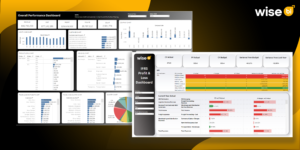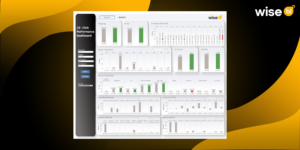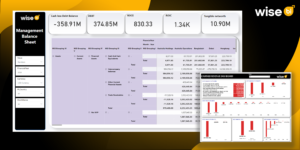The method of analysing a company’s financial performance about revenue (income) and the volume of goods or services sold. It is essential because it enables businesses to recognize trends, comprehend their financial situation, and make data-driven decisions that maximize operations and profitability.
Optimizing revenue and volume analysis is crucial for business success. Let us explore in this blog how Business Intelligence plays a vital role and the key metrics used in BI for analysing revenue and volume to manage logistics operations and gain a deeper understanding of financial performance for better future assurance.
Why BI is Essential for CargoWise Users
BI is essential for CargoWise users because it can convert massive amounts of data into usable insights, resulting in informed decision-making and strategic planning. However, manually reviewing spreadsheets can be time-consuming and limit your capacity to find hidden insights. BI platforms provide a smarter solution by;
Advanced Analytics and Visualization:
BI solutions provide more effective and efficient results by offering advanced analytics and visualization features for more effective and efficient solutions. CargoWise users may use BI to learn more deeply about their data, uncovering hidden trends, patterns, and anomalies that human analysis alone may not reveal.
For example, BI systems can reveal correlations between specific trade routes or client categories and revenue performance, allowing users to modify pricing tactics or uncover hidden growth potential.
Easy Performance Monitoring:
By enabling users to design unique dashboards suited to their requirements, business intelligence (BI) makes it easier for users to monitor performance. Key performance indicators (KPIs) include overall revenue, shipping volume, on-time delivery rates, and more on these dashboards.
CargoWise users may proactively monitor performance trends, identify areas for improvement, and make data-driven decisions to optimize their logistics operations by having this information easily accessible in a unified dashboard.
Customization is Essential:
Customization is another critical component of BI that increases its value for CargoWise users. BI platforms allow customers to create specific BI revenue and volume analysis dashboards to analyse certain areas of their operations, such as trade lanes, customer groups, or shipping kinds.
This level of personalization enables users to narrow their analysis to specific areas of interest or concern, resulting in detailed insights that can guide strategic efforts and promote operational improvements.
Simplified Data Integration:
BI solutions enable smooth data integration with CargoWise and other data sources. This integration assures data integrity and correctness in analysis, removing the need for human data manipulation and lowering the possibility of errors.
CargoWise users may rely on the insights offered by BI tools to help their decision-making processes when they have access to accurate and reliable data.
Exploring the Potential of Revenue and Volume Analysis
Determine Profitable Routes and Customers:
The capacity to precisely determine profitable routes and customers is a major benefit. CargoWise users may determine which client segments and trade lanes generate the maximum profits by examining the data that is collected within the platform. Companies can use this information to prioritize high-value clients, strategically allocate resources, and customize services to fit the needs of the market.
For instance, a CargoWise customer might see that some trade routes routinely bring in more money because of more demand or premium services; in this case, they might decide to concentrate their marketing efforts or modify their pricing plans.
Optimize Pricing Strategies:
By offering a thorough examination of the cost structures and profit margins connected to various routes and shipment kinds, BI helps CargoWise users optimize their pricing strategies. Businesses can create profitable pricing strategies that draw in customers and maintain sustainable profitability by comprehending the underlying cost dynamics of their business.
For example, a CargoWise user may be able to find ways to improve carrier rates, create value-added services that increase customer happiness support premium pricing, or streamline processes through BI analysis.
Enhance On-Time Delivery Performance:
One major way to enhance on-time delivery performance is through the use of BI-driven analysis. Users of CargoWise can monitor delivery rates for a range of carriers and routes, helping them spot inefficiencies, obstacles, and places where their logistics processes need to be improved.
To ensure on-time delivery and improve overall customer satisfaction, businesses can apply specific interventions, such as route optimization, inventory management improvements, or improved communication procedures with carriers, by identifying the underlying reasons for delays or disruptions.
Forecast Future Performance:
BI facilitates the forecasting of future performance by analysing historical trends and patterns within CargoWise data. By examining past revenue and volume data, companies can identify seasonal fluctuations, market trends, or emerging patterns that may impact future performance.
CargoWise users can create more accurate forecasts for budgeting, resource allocation, and strategic planning, enabling them to make proactive decisions that mitigate risks and capitalize on growth opportunities.
Wise BI’s Various Levels of Analysis
Group Level Analysis
CargoWise customers can undertake group-level analysis by combining data from different branches or departments to acquire a better understanding of overall performance and trends. This comprehensive perspective enables better decision-making and strategic planning at the business level.
Country-Level Analysis
CargoWise users can utilize BI to examine country-level performance, comparing revenue, volume, and operational indicators across regions. This research assists in identifying profitable markets, regulatory difficulties, and chances for development or optimization.
Department Level Analysis
BI enables CargoWise users to explore department-level data, such as sales, operations, or customer support. Users can find opportunities for improvement, enhance processes, and match plans with business objectives by examining department-specific KPIs.
Branch Level Analysis
CargoWise users can use BI at the branch level to monitor performance indicators, track operational efficiency, and identify areas for concern or success. Branch-level analysis enables focused interventions, resource allocation, and performance management that contribute to success.
Conclusion
To put it simply, BI is a strategic asset that enables CargoWise users to confidently and precisely manage the complexity of the logistics sector. Businesses can simplify their operations, turn data into meaningful insights, and grasp new chances for growth and profitability by embracing business intelligence (BI).
Are you prepared to take advantage of the potential of revenue and volume analysis in your CargoWise operations? Never hesitate to approach Wise BI solutions which can help you make better decisions and achieve operational excellence in your revenue and volume analysis.




